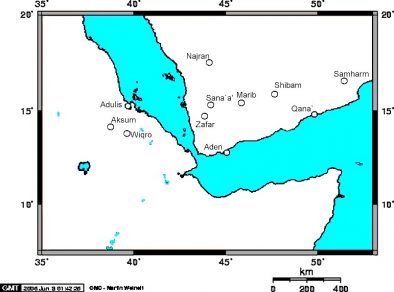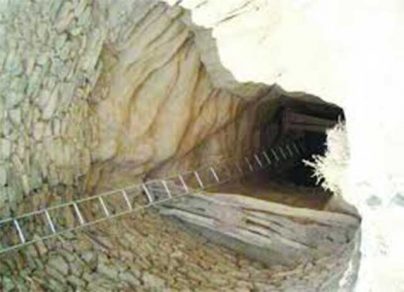
eager to settle in the Yemen, then a rich and fertile land. This event may have happened about 530 A.D. although a date as late as 543 has been postulated by Jacques Ryckmans. An army sent by Kaléb to subdue ‘Abraha joined his ranks and killed the ruler sent to replace him (this is perhaps a reference to ‘Ariat) and a second army was defeated. In the version of these events preserved by Tabari details vary slightly. ‘Abraha is said to have been the commander of the second army sent by Kaléb after the first, led by ‘Ariat, had been annihilated by Dhü Nuwäs through a ruse. This second army of 100,000 men successfully crushed all resistance and, following the suicide of Dhü Nuwäs, ‘Abraha seized power, establishing himself at Sana’a and proclaiming Christianity. He aroused the wrath of Kaléb, however, by withholding tribute and Kaléb sent his general ‘Ariat once again to take over the governorship of Yemen. ‘Abraha rid himself of the latter by a subterfuge in a duel in which ‘Ariat was killed and ‘Abraha suffered the injury which earned him the sobriquet of al-Asräm, “scar-face.” After this Kaléb had to accord him de facto recognition. ‘Abraha’s rule was probably confirmed by Kaléb successor, Emperor Bétä-‘Esra’él in return for nominal tribute and he went on to become an outstanding figure in Yemeni history, ruling efficiently and promoting the cause of Christianity in the face of the Judaism prevalent in Yemen and the paganism of Central Arabia.

of the Ka’aba and the pilgrim traffic was in the hands of the powerful Qurays family. Fired with Christian zeal, ‘Abraha set out to build a magnificent church at Sana’a to serve as a counter-attraction to the surrounding pagan peoples. This aroused the hostility of the Qurays who feared that the pilgrim traffic with its lucrative offerings would be diverted to Sana’a. It is sometimes said that one of their adherents succeeded in defiling the church and this led ‘Abraha to embark upon a campaign against Mecca. This event is associated in Islamic tradition with the year of the Prophet’s birth, c. 570 A.D. ‘Abraha is said to have used elephants in the campaign and the date is celebrated as the Year of the Elephant, ‘am al fil.’ An indirect reference to the event is found in Surah 105 of the Quran. ‘Abraha’s expedition probably failed due to the successful delaying tactics of the Qurays and pestilence broke out in the camp, which decimated his army and forced him to withdraw. Another tradition relates the expedition to an unsuccessful economic mission to the Qurays by ‘Abraha’s son.
Bibliography
T. Noldeke, Geschichte der Perser und Araber zur Zeit der Sassaniden (Leyden, 1879), 200 ff.
F. Praetorius, “Bemerkungen zu den beiden grossen Inschriften von Dammbruch zu Marib”, Zeitschrift der Deutschen Morgenländischen Gesellschaft, Vol. LIII, (1899), 1-24.
E. Glaser, “Zwei Inschriften über den Dammbruch von Mareb,” Mitteillungen der Vorderasiatischen Gesellschaft, VI (1897), 360-488.
A. Wiedemann in Orientalische Letteratur-Zeitung, 1 (1898).
Procopius (H. B. Dewing, ed.), De Bello Persico (London, 1957), I, xx.
Tabari (H. Zotenberg, ed. and trans.), Chronique (Paris, 1958), Vol. II, 184-208.
J. Ryckmans, L’institution monarchique en Arabie méridionale (Louvain, 1951).
——–, La persécution des chrétiens himyarites au sixième siècle (Istanbul, 1956).
Sidney Smith, “Events in Arabia in the 6th century A.D.,” Bulletin of the School of Oriental and African Studies, Vol. XVI (1954).
A. F. L. Beeston, ABRAHA in Encyclopaedia of Islam (1960).
——–, “Problems of Sabaen Chronology,” Bulletin of the School of Oriental and African Studies , Vol. XXVI (1954).
M. J. Kister, “The Campaign of Huluban. A New Light on the Expedition of ‘Abraha,” Le Muséon, Vol. LXXVIII (1965).
Sergew Hable-Selassie, *Ancient and Medieval Ethiopian History to 1270 *(Addis Ababa, 1972).
This article is reproduced, with permission, from The Dictionary of Ethiopian Biography, Vol. 1 ‘From Early Times to the End of the Zagwé Dynasty c. 1270 A.D.,’ copyright © 1975, edited by Belanesh Michael, S. Chojnacki and Richard Pankhurst, Institute of Ethiopian Studies, Addis Ababa, Ethiopia. All rights reserved.



